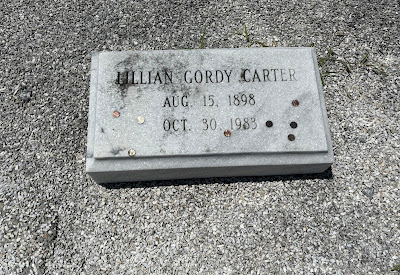Today is Jimmy Carter's 100th birthday - the only president to ever have lived to be 100 years old. We were recently in his home town of Plains, Georgia so it only seems fitting to post this today.
Plains is just a short drive from Andersonville so we continued our drive to see where Jimmy Carter was born and raised. Our first stop was Plains High School which is now the Jimmy Carter National Historic Site.
Plains High School was built in 1921 at the cost of $50,000. For many years, this institution served as the primary center for education, offering grades one through eleven, with students graduating after the eleventh grade. Plains High School did not include a twelfth grade until 1952. The high school played a pivotal role in the lives of both Jimmy and Rosalynn Carter - Jimmy Carter received his diploma in 1941 and Rosalynn graduated valedictorian in 1944.
After serving as a school for many decades, Plains High School closed its doors in 1979. However, its legacy lives on as it has been transformed into a park museum and visitor center. These spaces offer a glimpse into the past, providing an authentic sense of what education was like during the Carter's school years.
I wonder if Jimmy or Rosalynn sat in this classroom.
Or participated in a special event in this auditorium.
There were also some Carter memorabilia on display.
This poem to Rosalynn is sweet.
As most presidential libraries have, there was an Oval Office display. We took the opportunity to place a few calls.
From there we were off to Jimmy Carter's Boyhood Farm.
This home was owned by Earl Carter, Jimmy's father, and dates back to 1928 when it came under the Carter's ownership. For over two decades, Earl Carter cultivated a variety of crops, including corn, cotton, peanuts and sugar cane, as well as a large family garden. Jimmy called this place home from the age of four until he left for college.
One of Jimmy Carter's earliest and most vivid memories revolves around the day they moved into their new home.
"The front door was locked when we got there, and daddy realized that he had forgotten the key. He tried to raise one of the windows that opened onto the front porch, but a wooden bar on the inside let it come up only about six inches. So he slid me through the crack and I came around to unlock the door from the inside. The approval of my father for my first useful act has always been one of my most vivid memories."
Earl Carter sold the farm to T.R. Downer in 1949 and the Downer family owned the property until 1994 when the National Park Service purchased it.
In 2000, the Boyhood Farm underwent a restoration process to recreate its appearance as it was before electricity was installed in 1938.
We walked up to the home to look around. It was interesting that at no time did we see anyone, not even a guide or park ranger, anywhere on the property.
Jimmy's two sisters, Gloria and Ruth, shared this bedroom. For birthdays and other special occasions they had sleepover company. After falling asleep, guests would awaken and sometimes go into hysterics when the train came by the front of the house at about 2:00 a.m. It sounded terrible, as if the train was coming right through the house.
Phew, glad to see there was a bathroom with running water. We'd seen an outhouse on the way in.
The Boyhood Farm continues to thrive with the same agricultural spirit. The farm is home to honeybees, goats, chickens, mules, and farm cats, all contributing to the authentic farm atmosphere. Crops are still grown periodically throughout the year, which includes sugarcane, cotton, corn, tomatoes and, of course, peanuts, a crop closely associated with the Carters.
These pecan trees belonged to Jimmy Carter's mother, "Miss Lillian." His father, "Mr. Earl", planted the grove soon after the family moved here in 1928. Each fall, Miss Lillian harvested and sold her pecans in nearby Americus. The extra income provided her with household spending money throughout the rest of the year.
If you look closely in the upper left corner you can see Jimmy's handprints that he placed in the concrete as a young child.
As we drove into "town", we made a stop at the cemetery. When Jimmy dies (he stated he wanted to live to 100 - he made it!), he will join Rosalynn (who is being held "in waiting") at their home in Plains where Jimmy lives today.
Our last stop was "downtown" Plains where they are very proud of their favorite son.
In the center of town is the Plains Depot, a living testament to the town's rich history. Constructed in 1888, it stands proudly as the oldest building in Plains, having witnessed over a century of change and growth. Originally, the Plains Dept played a vital role in the community, serving as both a freight and passenger depot until 1951 when passenger service was discontinued.
In 1976, the Plains Depot took on a new role in town's history when it became the center for Jimmy Carter's presidential campaign. During this time, approximately 10,000 people a day flocked to Plains, eager to learn more about the candidate. It was at the Plains Depot that many state primary victories and, ultimately, the historic presidential victory were celebrated.
We walked across the street to the Carter Warehouse.
It was a great stop and so glad that we can celebrate Jimmy today.
Happy 100th birthday, Jimmy!!!


































































